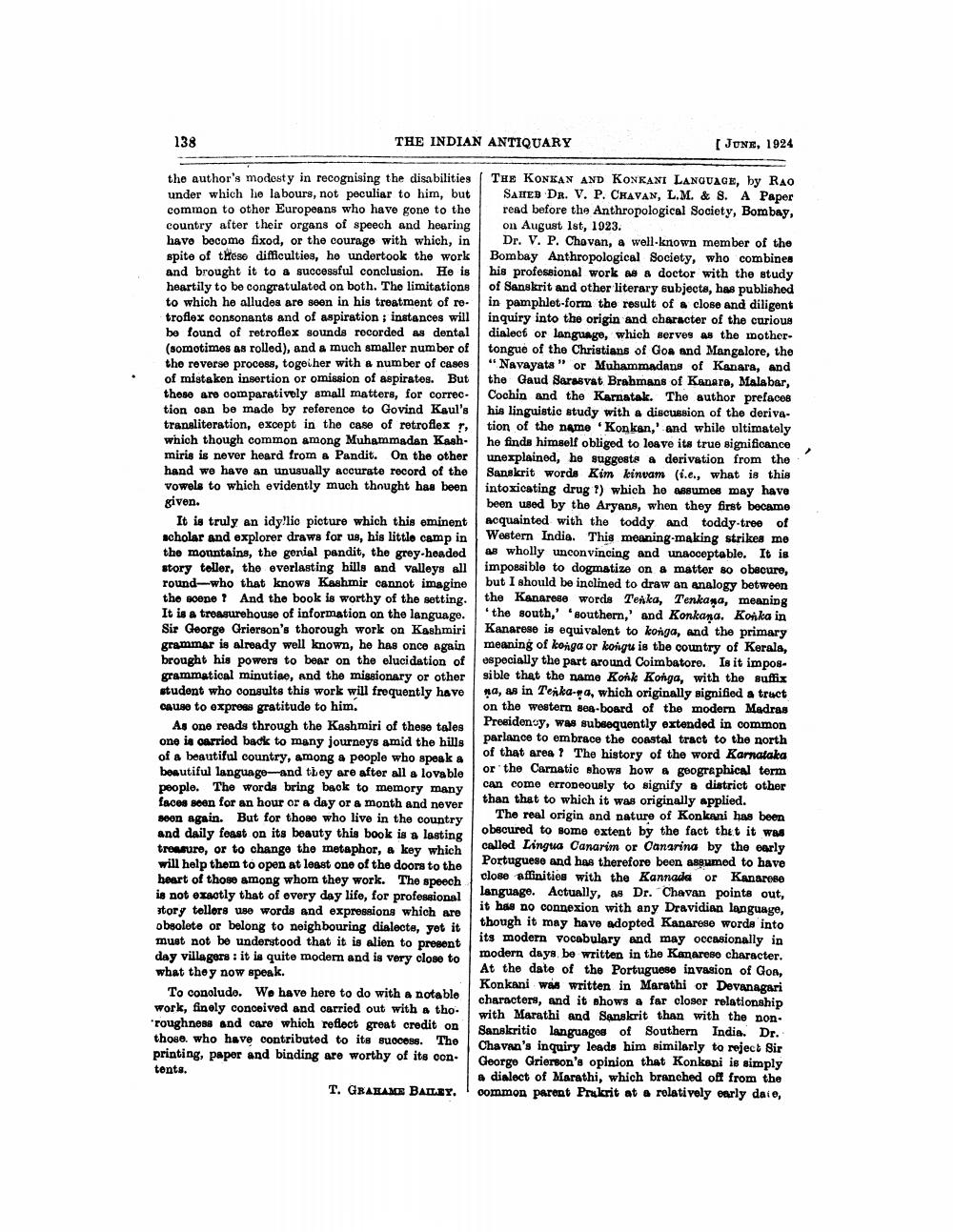________________
138
THE INDIAN ANTIQUARY
[June, 1924
the author's modesty in recognising the disabilities under which le labours, not peculiar to him, but common to other Europeans who have gone to the country after their organs of speech and hearing havo becomo fixod, or the courage with which, in spite of these difficulties, ho undertook the work and brought it to a successful conclusion. He is heartily to be congratulated on both. The limitations to which he alludes are seen in his treatment of retroflex consonants and of aspiration, instances will be found of retroflex sounds recorded as dental (somotimes as rolled), and a much smaller number of the roverso process, togeiher with a number of cases of mistaken insertion or omission of aspirates. But those are comparatively small matters, for correc. tion can be made by reference to Govind Kaul's transliteration, except in the case of retroflex , which though common among Muhammadan Kashmiris is never heard from a Pandit. On the other hand we have an unusually accurato record of the vowels to which evidently much thought has been given.
It is truly an idyllio picture which this eminent scholar and explorer draws for us, his little camp in the mountains, the genial pandit, the grey-headed story teller, the everlasting hills and valleys all round-who that knows Kashmir cannot imagine the soepe ! And the book is worthy of the setting. It is a treasure house of information on the language. Sir George Grierson's thorough work on Kashmiri grammar is already well known, he has once again brought his powers to bear on the elucidation of grammatical minutise, and the missionary or other student who consults this work will frequently have CAUNO to express gratitude to him.
As one reads through the Kashmiri of these tales one is carried back to many journeys amid the hills of a beautiful country, among a people who speak a beautiful language and they are after all a lovable people. The words bring back to memory many lacos soon for an hour or a day or a month and never soon again. But for those who live in the country and daily feast on its beauty this book is a lasting trourure, or to change the metaphor, a key which will help them to open at least one of the doors to the heart of those among whom they work. The speech is not exactly that of every day life, for professional story tellors use words and expressions which are obsolete or belong to neighbouring dialecte, yet it must not be understood that it is alien to present day villagers : it is quite modern and is very close to what they now speak.
To conoludo. Wo have here to do with a notable work, finely conceived and carried out with a tho. 'roughness and care which reflect great credit on those who have contributed to its success. The printing, paper and binding are worthy of its oon. tonta.
T. GRAHAME BAILEY.
THE KONKAN AND KONKANI LANGUAGE, by RAO
SAHED DR. V. P. CHAVAN, L.M. & 8. A Paper read before the Anthropological Society, Bombay, on August 1st, 1923.
Dr. V. P. Chovan, a well-known member of the Bombay Anthropological Society, who combines his professional work as a doctor with the study of Sanskrit and other literary subjects, has published in pamphlot-form the result of a close and diligent inquiry into the origin and character of the curious dialect or language, which serves as the mothertongue of the Christians of Goa and Mangalore, the "Navayata" or Muhammadans of Kanara, and the Gaud Sarasvat Brahmans of Kanara, Malabar, Cochin and the Karnatak. The author prefaces his linguistic study with a discussion of the derivetion of the name Konkan,' and while ultimately he finds himsell obliged to leave its true significance unexplained, he suggests a derivation from the Sanskrit words Kim kinuam (i.e., what is this intoxicating drug ?) which ho msumes may have been used by the Aryans, when they first bocamo acquainted with the toddy and toddy-tree of Western India. This meaning-making strikes me a wholly unconvincing and unacceptable. It is impossible to dogmatize on a matter Bo obecure, but I should be inclined to draw an analogy between the Kanarese words Tenka, Tenkaya, meaning
the south,' southern,' and Konkana. Konka in Kanarese is equivalent to konga, and the primary meaning of konga or korigu is the country of Kerala, especially the part around Coimbatore. Is it impossible that the name Konk Konga, with the suffix na, as in Tenka-pa, which originally signified a truct on the western sea-board of the modern Madras Presidensy, was subsequently extended in common parlance to embrace the coastal tract to the north of that area ? The history of the word Karnataka or the Carnatio shows how a geographical term can come erroneously to signify a district other than that to which it was originally applied.
The real origin and nature of Konkani has been obscured to some extent by the fact that it was called Lingua Canarim or Canarina by the early Portuguese and has therefore been asgumed to have close affinities with the Kannada or Kanarece language. Actually, as Dr. Chavan points out, it has no connexion with any Dravidian language, though it may have adopted Kanarese words into its modern vocabulary and may occasionally in modern days be written in the Kanareso character. At the date of the Portuguese invasion of Gon, Konkani was written in Marathi or Devanagari characters, and it shows a far closer relationship with Marathi and Sanskrit than with the nonSanskritio languages of Southern India. Dr. Chavan's inquiry leads him similarly to reject Sir George Grierson's opinion that Konkspi is simply a dialect of Marathi, which branched off from the common parent Prakrit at a rolatively early daie,




